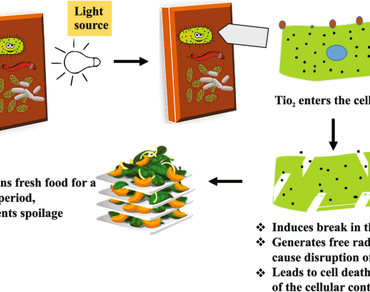Titanium dioxide nanomaterials coated films in food packaging: a mini review
Review Articles | Published: 18 May, 2022
First Page: 565
Last Page: 570
Views: 3835
Keywords: TiO2 , Nanocoating, Food packaging, UV barrier, Antimicrobial
Abstract
Nanomaterials with interesting physical as well as chemical properties are currently being investigated for potential applications in energy, food and environmental applications. Titanium dioxide (TiO2) nanocomposite films prevailed substantial focus in the different sectors because of their bright prospects in photocatalysis, UV barrier, antimicrobial ability and treating environmental pollution. Research on the shelf life of certain nanocomposite with TiO2 coated food packaging have also shown high resistant to mass loss and deterioration during storage. This review focused on UV barrier and antimicrobial characteristics of nano packaging and presented an overview of the risk factors associated.
Graphical abstract


References
Abdollahi M, Damirchi S, Shafafi M et al (2019) Carboxymethyl cellulose-agar biocomposite film activated with summer savory essential oil as an antimicrobial agent. Int J Biol Macromol 126:561–568
Aguilera JM (2014) Where is the nano in our foods? J Agric Food Chem 62:9953–9956
Ahvenainen R (2003) Novel food packaging techniques. Elsevier, Berlin
Alfei S, Marengo B, Zuccari G (2020) Nanotechnology application in food packaging: a plethora of opportunities versus pending risks assessment and public concerns. Food Res Int 137:109664
Arman Alim AA, Mohammad Shirajuddin SS, Anuar FH (2022) A review of nonbiodegradable and biodegradable composites for food packaging application. J Chem. https://doi.org/10.1155/2022/7670819
Aziz MSA, Salama HE, Sabaa MW (2018) Biobased alginate/castor oil edible films for active food packaging. LWT 96:455–460
Balasubramanian R, Kim SS, Lee J, Lee J (2019) Effect of TiO2 on highly elastic, stretchable UV protective nanocomposite films formed by using a combination of k-Carrageenan, xanthan gum and gellan gum. Int J Biol Macromol 123:1020–1027
Bastarrachea L, Dhawan S, Sablani SS (2011) Engineering properties of polymeric-based antimicrobial films for food packaging: a review. Food Eng Rev 3:79–93
Bonetta S, Bonetta S, Motta F et al (2013) Photocatalytic bacterial inactivation by TiO 2-coated surfaces. AMB Express 3:1–8
Bouwmeester H, van der Zande M, Jepson MA (2018) Effects of food-borne nanomaterials on gastrointestinal tissues and microbiota. Wiley Interdiscip Rev Nanomed Nanobiotechnol 10:e1481
Chawengkijwanich C, Hayata Y (2008) Development of TiO2 powder-coated food packaging film and its ability to inactivate Escherichia coli in vitro and in actual tests. Int J Food Microbiol 123:288–292
Chen Z, Han S, Zhou S et al (2020) Review of health safety aspects of titanium dioxide nanoparticles in food application. NanoImpact 18:100224
Chun AL (2009) Will the public swallow nanofood? Nat Nanotechnol 4:790–791
Deng X, Mammen L, Zhao Y et al (2011) Transparent, thermally stable and mechanically robust superhydrophobic surfaces made from porous silica capsules. Adv Mater 23:2962–2965
Domard A, Domard M (2002) Chitosan: structure-properties relationship and biomedical applications. Polym Biomater 9:187–212
Dudefoi W, Terrisse H, Richard-Plouet M et al (2017) Criteria to define a more relevant reference sample of titanium dioxide in the context of food: a multiscale approach. Food Addit Contam Part A 34:653–665
Duncan TV (2011) The communication challenges presented by nanofoods. Nat Nanotechnol 6:683–688
Goudarzi V, Shahabi-Ghahfarrokhi I, Babaei-Ghazvini A (2017) Preparation of ecofriendly UV-protective food packaging material by starch/TiO2 bio-nanocomposite: characterization. Int J Biol Macromol 95:306–313
Heringa MB, Geraets L, van Eijkeren JCH et al (2016) Risk assessment of titanium dioxide nanoparticles via oral exposure, including toxicokinetic considerations. Nanotoxicology 10:1515–1525
Lan W, Wang S, Zhang Z et al (2021) Development of red apple pomace extract/chitosan-based films reinforced by TiO2 nanoparticles as a multifunctional packaging material. Int J Biol Macromol 168:105–115
Nakajima A, Hashimoto K, Watanabe T (2001) Recent studies on super-hydrophobic films. In: Molecular materials and functional polymers. Springer, Berlin, pp 31–41
Othman SH, Abd-Salam NR, Zainal N et al (2014) (2014) Antimicrobial activity of TiO2 nanoparticle-coated film for potential food packaging applications. Int J Photoenergy 2014:5
Salama HE, Aziz MSA (2020a) Optimized alginate and Aloe vera gel edible coating reinforced with nTiO2 for the shelf-life extension of tomatoes. Int J Biol Macromol 165:2693–2701
Salama HE, Aziz MSA (2020b) Optimized carboxymethyl cellulose and guanidinylated chitosan enriched with titanium oxide nanoparticles of improved UV-barrier properties for the active packaging of green bell pepper. Int J Biol Macromol 165:1187–1197
Salama HE, Aziz MSA, Alsehli M (2019a) Carboxymethyl cellulose/sodium alginate/chitosan biguanidine hydrochloride ternary system for edible coatings. Int J Biol Macromol 139:614–620
Salama HE, Aziz MSA, Sabaa MW (2019b) Development of antibacterial carboxymethyl cellulose/chitosan biguanidine hydrochloride edible films activated with frankincense essential oil. Int J Biol Macromol 139:1162–1167
Shankar S, Tanomrod N, Rawdkuen S, Rhim J-W (2016) Preparation of pectin/silver nanoparticles composite films with UV-light barrier and properties. Int J Biol Macromol 92:842–849
Sharma C, Dhiman R, Rokana N, Panwar H (2017) Nanotechnology: an untapped resource for food packaging. Front Microbiol 8:1735
Siegel RW (1991) Cluster-assembled nanophase materials. Annu Rev Mater Sci 21:559–578
Singh T, Shukla S, Kumar P et al (2017) Application of nanotechnology in food science: perception and overview. Front Microbiol 8:1501
Stamate M, Lazar G (2007) Application of titanium dioxide photocatalysis to create self-cleaning materials. Rom Technol Sci Acad 13(3):280–285
Urrutia-Ortega IM, Garduño-Balderas LG, Delgado-Buenrostro NL et al (2016) Food-grade titanium dioxide exposure exacerbates tumor formation in colitis associated cancer model. Food Chem Toxicol 93:20–31
Willats WGT, Knox JP, Mikkelsen JD (2006) Pectin: new insights into an old polymer are starting to gel. Trends Food Sci Technol 17:97–104
Wyser Y, Adams M, Avella M et al (2016) Outlook and challenges of nanotechnologies for food packaging. Packag Technol Sci 29:615–648
Xing Y, Yi R, Yang H et al (2021) Antifungal effect of chitosan/Nano-TiO2 composite coatings against Colletotrichum gloeosporioides, Cladosporium oxysporum and Penicillium steckii. Molecules 26:4401
Yao N, Yeung KL (2011) Investigation of the performance of TiO2 photocatalytic coatings. Chem Eng J 167:13–21
Zhang X, Xiao G, Wang Y et al (2017) Preparation of chitosan-TiO2 composite film with efficient antimicrobial activities under visible light for food packaging applications. Carbohydr Polym 169:101–107
Author Information
Centre for Materials Engineering and Regenerative Medicine, Bharath Institute of Higher Education and Research, Chennai, India